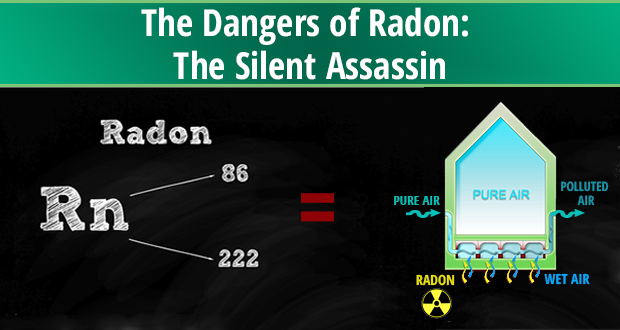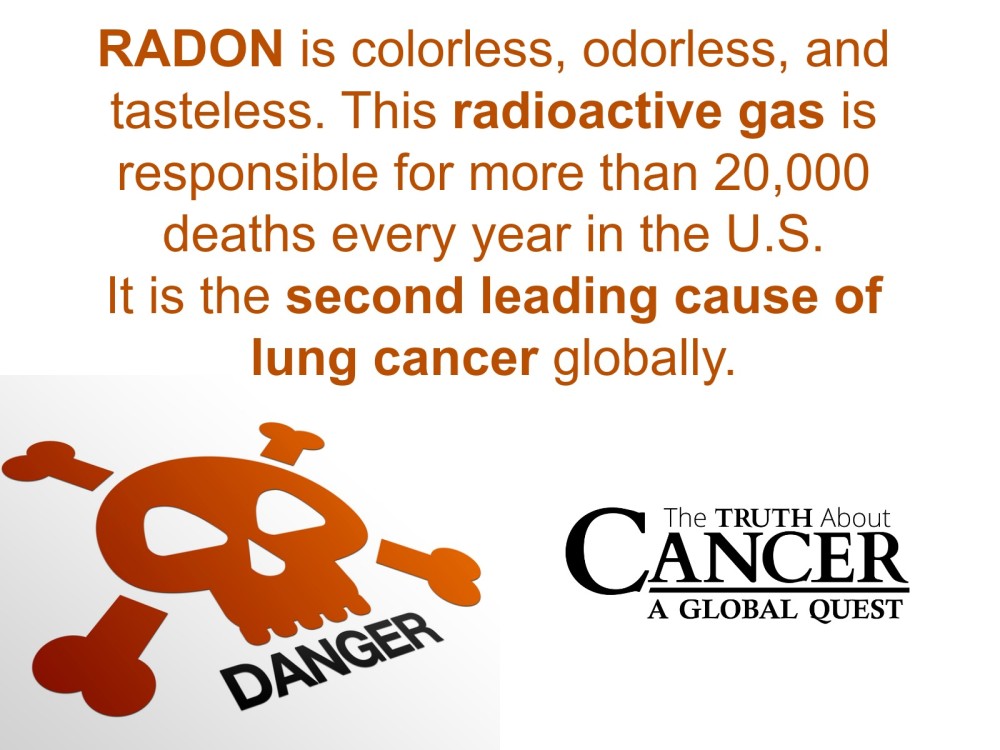Radon has no color or smell. There is absolutely nothing to alert you to any threat of danger.
It is one of the second highest cause of lung cancer worldwide, resulting in more than 20,000 deaths in the United States annually.
The primary dangers of radon is that it is potentially everywhere. It is a naturally occurring radioactive gas that is produced from the decay of radioactive elements – such as uranium – in the earth’s rocks and soil. Radon gas can also contaminate ground and well water.
For most people, the risk of radon exposure usually comes from where they live and depends on several factors.
- The amount of uranium found in rocks and the soil beneath the place of residence.
- Entry points for radon to enter the home such as cracks between concrete (usually found in the floor-to-wall junctions), gaps in tiles or the floor, small pores found in hollow-block walls, drains, and sump-pumps.
- The exchange rate between indoor and outdoor air. Homes that are always sealed (a common occurrence in climates that are cold or hot year-round) tend to have higher levels of radon gas. Airing out a home allows outside air to dilute concentration.
- Homes with poor ventilation or poorly sealed.
As a rule, radon gas levels are highest in the basement, cellars, or other parts of the home that come in direct contact with the soil.
When radon gas escapes into the air of the home, it breaks down into smaller radioactive particles. These particles latch on to aerosols, dusts, and other air-borne substances. When we breathe this contaminated air, these same particles enter into our lungs, are deposited into the cells lining our airways, and begin damaging DNA structure.
This damage, when unchecked, can ultimately lead to lung cancer.
Researchers have revealed that, while it is true elevated levels of radon can increase the chances of one developing lung cancer, a surprising number of people develop lung cancer despite concentration levels being in the low to middle range.
This could be because some people spend more time in their homes, where the danger of radon gas exposure is more likely. Radon gas is also the primary cause of lung cancer in non-smokers, and if the patient is a smoker, the risk of lung cancer is much higher.
Lower the Risk of Radon in Your Home
- Block the passage of air from basements and cellars to the regular living floors by using a tightly sealed door between levels.
- Increase under-floor ventilation.
- Install a radon sump system in the basement.
- Properly seal the floors and walls.
- Install radon detectors in every zone of your home.
- Ask your local water supply company for radon concentration in your location.
- Have your home inspected for radon or test it yourself with an inexpensive kit.
These are just some of the things that we can do to reduce the risk of radon exposure for ourselves and loved ones right at home where the undetected gas is most damaging.




















Thank you Ty and Charlene for your sacrificial serving us to get the message of hope out there!
So why would the ground under your house outgas more radon than the ground in your yard, in the park, in the mountains, or anywhere else? This doesn’t make sense.
It’s not that there is more under your house, but you don’t live above the radon in your yard or park and breathe in what’s coming up from the ground in those spots.
If it’s coming out of the ground, it will be everywhere there is ground nearby, meaning that the only place to get away from it might be on the ocean or living at the beach with an onshore airflow (unless now Fukushima has made that air just as dangerous).
Radon in contact with the air will dissolve almost immediately, while in the house/basement/first floor where there is no good ventilation, will accumulate easily, then you can breath it in. Can reach very high levels indoors, especially during winter when windows are closed. While outdoor is usually 0.1, indoors can reach very high values, like 15, 18 depending on how much uranium is under the house/region, deep down in the ground. A value of 3 is equivalent to smoking 2 packs of cigarettes per day plus a chest x-ray every other day.
My mom passed from lung cancer. She did hair in our basement for a number of years. Years later we found out about the lung cancer got the radon levels tested and they were high. She did the chemo and radiation which sucked because idk how to explain but simple way is to say “it cooked it like popcorn” made it spread and she passed with in four months.
Sucks because the doctors know how long basically she had to live because they see this happen a lot I assume. Also to keep her comfortable” the drugs for the pain I feel helped her pass. As weird as that sounds it’s crazy how easily one can be induced with drugs and no one knows how it’s slowly killing them from inside out. 🙁 if I only could have her back. At least I’ll never to chemo or radiation. Keep ur ph levels right ppl!
I’m sorry to hear about your mother. One of the many doctors whose lectures I’ve listened to was saying, “And if you’re a hair dresser, don’t bother saving for retirement. You won’t need it. Just make sure your will is in order” (because of the cancer-causing chemicals hair dressers are constantly breathing and touching). Now after learning a lot (a thousand hours’ research in a year and a half) about cancer and the corrupt cancer industry, I beg people not to submit to destructive and counterproductive chemo and radiation, but instead to fix their diet, quit the toxins, and alkalize (going into a little more detail of course).
Great article! I’ve been a Home Inspector since 2014 and also test for radon. I can’t believe how many people I run into that are just clueless about its dangers. Thanks for writing this.
I am in the process of buying a home in the N C mountains.. The inspector just informed me that I have a reading of 6.3. He says the EPA says it should be no higher than 4.0. Is this reading high enough that I should not buy?
Since you said that homes with poor ventilation or poor sealing are susceptible to radon, it may be the reason why my radon testing was so high. I’ll be sure to increase under-floor ventilation as you suggested in order to mitigate radon levels in my home. If possible, I’ll have professionals install a radon sump system in order to lower its levels in the basement so that I’ll have fewer risks for cancer.
I wasn’t aware that radon has no color or smell so it might be in my house right now. Since it’s potentially everywhere, I’ll call some services to remove it once I find out if there is radon in my house. I’ll make sure to have them install a sump pump as well so that it won’t go anywhere else as well.
I did not even know that radon had no color or smell. Who knows maybe it is inside my house, but I do not know anything about it. I know that there is asbestos in the airducts in my house because my house was built in 1954 and it is 66 years old.
What about the radon spa therapy that is common in Germany and paid sometimes by their health insurance? How does that work? Bad Gastein in Austria is one example. Are they using different amounts or a different type of radon gas?
I think Radon is a complex subject with a lot on controversy. Through doing a little independent research you will find several things interesting. Like the fact that most radon gauges they sell do not measure radon concentrations but decay activity. What’s interesting about this is a level measured at 1 pci/l vs 9 could have the same concentrations (exposure). Meaning 1 could be the same or more harmful than a level of 9 in some cases. What is also interesting is the linear no-threshold model (LNT) model for prediction is not a good model to predict risk at low levels, a lot of scientists agree about this.
Here is an interesting site about radon to do further investigating.
http://www.forensic-applications.com/radon/radon.html
From what I can understand, putting an active mitigation system in a home with a crawlspace puts a neg pressure below a plastic membrane that can dehumidify/remove radon, but it also gets rid of potential mold issues and structural issues (along with a dehumidifier). The neg pressure stops the chimney effect within the house. This intern increases air quality in the home.
I don’t think the level of radon is a problem with most homes, it could be, however, I have never seen any valid data to support this. I cannot find any actual data that says low levels (4 ) of radon causes cancer or is associated with cancer. The EPA and other only say estimates but not based on any scientific data or real facts if you try to dig for the answers.
If people want to believe it’s a concern, fix your home. It’s your choice.
The major concern I believe is humidly and mold concerns, but this depends on where you live. Humidity and mold can be a serious problem to the structure and your health. Dehumidification and extraction of moisture in a crawlspace in certain homes can provide a lot of Longterm value for the home and your health.